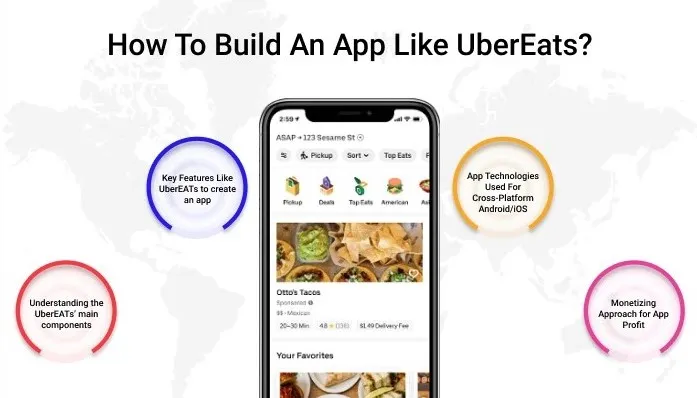
The food delivery industry has seen explosive growth in recent years, driven by growing demand for effortless on-demand services. With platforms like UberEats and DoorDash revolutionizing the way consumers order food, the emphasis has shifted to developing innovative food delivery apps. These apps offer customers the ability to place orders from their favorite restaurants and have it delivered directly to their location. For companies, the task is to utilize technology to improve delivery operations and ensure a smooth customer experience.
Building the Perfect Food Delivery App
Creating a successful food delivery app demands a thorough understanding of the industry shifts and operational strategies that lead the industry. Whether building a full-stack delivery solution or concentrating on niche markets like virtual restaurants or cloud kitchens, the app’s functionality needs to serve to both customers and restaurants. Key features such as real-time order monitoring, efficiency improvement, and customer satisfaction indicators play a vital role in guaranteeing customer loyalty.
Restaurant Delivery Partnerships: A Winning Strategy
Restaurants are increasingly forming partnerships with delivery platforms to increase their customer reach. These partnerships assist restaurants provide to a wider audience while reducing the obstacles of running their own delivery services. The success of such alliances depends on technological synchronization, which boosts the app usability and enhances the user satisfaction. Through these collaborations, restaurants can increase brand loyalty and make sure that they remain relevant in a saturated market.
How KPIs Drive Food Delivery Profitability
For any enterprise, understanding its key performance indicators (KPIs) is essential to ensuring profitability. In the food delivery industry, KPIs such as time efficiency, precision in orders, and customer satisfaction are essential. Tracking and improving these KPIs enables delivery services to provide a better customer experience. Additionally, keeping an focus on financial success helps companies streamline operations, lower delivery fees, and increase overall efficiency.
Customer Satisfaction and User Retention Strategies
A significant factor in the growth of food delivery platforms is their ability to retain users through excellent customer service. Providing fast food delivery and resolving customer reviews swiftly can help companies enhance their service delivery. Moreover, introducing loyalty programs and providing incentives like no-cost delivery can increase customer loyalty. User happiness can be additionally bolstered by ensuring quality assurance and offering a seamless order management system.
The Role of Technology in Food Delivery
Technology is at the heart of modern food delivery services, helping companies refine their operations and deliver a smooth customer experience. From mobile app development to real-time delivery tracking systems, technology plays a significant role in the success of delivery platforms. The application of data analytics to analyze user profiles and preferences allows delivery services to provide customized experiences, further enhancing customer interaction.
Competitive Analysis in the Food Delivery Market
The delivery sector is highly competitive, with numerous players competing for market share. Conducting a competitive analysis enables companies to assess their position in the market and identify chances for growth. Delivery platforms must stand out by offering unique features such as ghost kitchen services, quick service, or niche cuisine options. Understanding sector dominance and consumer behavior enables companies to customize their services and stay ahead of the competition.
The Impact of the Pandemic on Food Delivery Services
The global health crisis has had a substantial impact on the food delivery industry, accelerating its expansion as more people turned to delivery services due to social distancing guidelines. The shift has emphasized the necessity of digital transformation in the culinary sector, with restaurants rapidly adopting e-commerce platforms and delivery apps. As the world adapts to new normals, delivery services must continue innovating to meet evolving consumer demands and secure market expansion.
Investing in Food Delivery Startups
The food delivery industry presents numerous entrepreneurial chances, with investors eager to support companies that provide innovative solutions. From creating UberEats clones to developing niche delivery apps, entrepreneurs have a range of paths to pursue. Investors Future Trends in On-Demand Food Delivery seek out strong business models and the ability to scale, particularly in areas like delivery network optimization, user experience (UX), and technological advancement. By focusing on these areas, startups can secure substantial investments and establish themselves in the industry.
Enhancing Food Delivery Service Profitability and Expansion
Expanding a food delivery service demands Get Started a strong base built on market penetration, cost models, and unique offerings. As regional platforms expand, businesses should focus on establishing a reliable delivery network and ensuring quality standards. In addition, widening the menu options, forming new restaurant partnerships, and adopting advanced technology in food delivery will drive further expansion. By continually enhancing delivery times and ensuring high user happiness, companies can maintain a competitive edge and increase income streams.
These topics provide a complete understanding of the service landscape, with a emphasis on key aspects that propel the industry forward. Whether you’re a startup or an established company, concentrating on these factors will assist you succeed in the competitive world of food delivery.